|
3rd Battalion Royal Australian Regiment
Your FaithfullyJapan - Korea - Malaya - Borneo - Vietnam - East Timor - Solomons - Iraq - Afghanistan |
3rd Battalion
Royal Australian Regiment
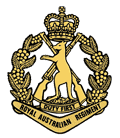
Korea
Operation Commando / Battle for Maryang San
2 - 8 October, 1951
Colonel Peter Scott DSO (RL)
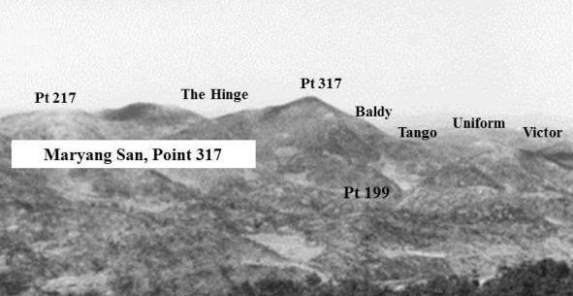
Maryang San, Point 317
Maryang San as seen by 3RAR O group for capture of cone shape 317. at range 3.7 kilometers.
1 KOSB to capture Pt 355 on 3 October, 1951. This is due west of OP, out of picture, at a distance of 2.5 kilometers.
3 RAR to capture Pt 199 as a support base for support of 1 KOSB. 3RAR to capture Pt 317 and the Fusiliers Pt 217 on 5 October. Chinese 571 st Regiment had a battalion well dug in on 355. (217and 317 plus a third battalion in reserve.
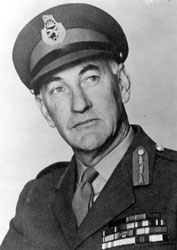
General Sir Francis G. Hassett AC KBE CB DSO NVO
We are looking through CO 3RAR Lt. Col F.G. Hassett's eyes. What is your outline plan and equally important, how are you going to execute it over the next six days? Maps herein give detail.
Battle for Maryang San
After the battle of Kapyong on 24/25 April 28th British Commonwealth Brigade had moved south to Yangpyong as IX Corps reserve and then relieved the 19th U.S. Regimental Combat Team at Yangsu-ri. 3RAR, as part of 28th British Commonwealth Brigade, spent the next couple of weeks building a defensive position and becoming accustomed to a more static environment with extensive patrolling particularly at night. The Chinese attacked on 17 May with little result which allowed 28th Brigade to advance some 20 kilometers north in the next five days. After a few days in reserve the brigade was ordered to take up a defensive position on the right of 29th British Infantry Brigade just south of the Imjin River where it was to remain for the next three months. 3RAR was on the left with the forward companies occupying a 120 metre feature called the 'Lozenge'.
The Australians had been continuously on operations since the end of September 1950 and had suffered over 350 battle and an unknown number of non-battle casualties. Although there was a trickle of replacements during these operations most reinforcements started to arrive in May to replace these casualties and those who were eligible for reposting to Australia after two years in Japan and Korea including eight months in Korea. Replacements occurred on an individual basis and this meant a dramatic change over of personnel during the middle months of 1951 involving all ranks from the commanding officer down. Although 103 reinforcements marched into the battalion during the month of September, 128 marched out on reposting for a net loss of 25. Not a satisfactory result. It was in this challenging period that Lieutenant Colonel Frank G.Hassett arrived to take over command from Lieutenant Colonel Bruce Ferguson.
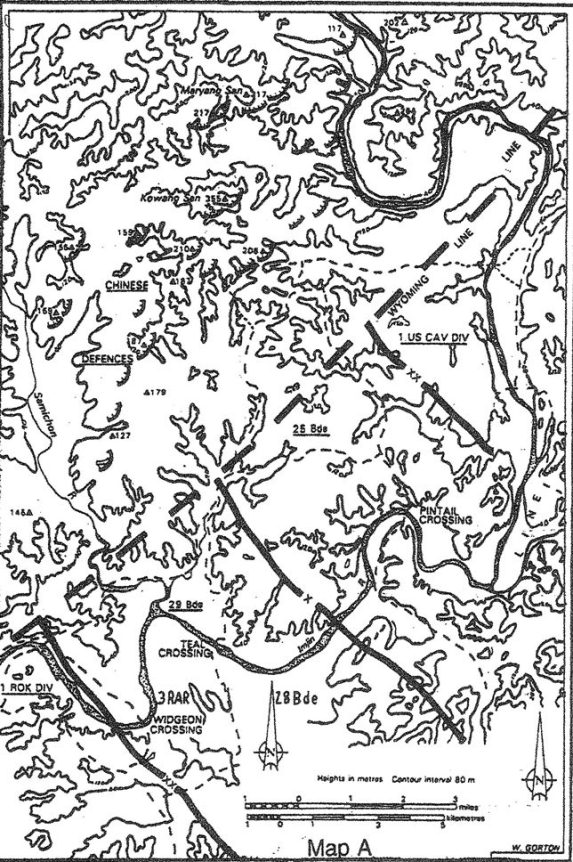
Lieutenant Colonel Hassett said later "At times I thought I was commanding a 'transit depot' in action. The other big downside was that the battalion was under strength. The rate of reinforcements not matching the wastage. The rifle companies were about 80 strong, as compared with an establishment figure of about 120. These conditions of turbulence and low strength still applied in October, the time of the battle.(1)
Very young and newly graduated officers from the Royal Military College arrived along with other older graduates and officers commissioned during World War 2 and the CMF. I had graduated in December 1948 and served in 3RAR in Japan in 1949-50 but was evacuated to Australia in August after a grenade accident.
I returned to the battalion on 17 July 1951 and was given 3 Platoon to command located on the 'Lozenge' for two months before becoming the Intelligence Officer on 25 September in time for Operation Commando. One of the members of my platoon was one Private R.S. Simpson who was later to be awarded the VC and DCM in Vietnam. The Chinese main forces had withdrawn well north of the Imjin River to recover from their recent maulings but left small elements forward to challenge any United Nations patrols which ventured north across the river. Peace negotiations also commenced about this time so both sides were keen to assert their authority and position themselves to the best advantage.
The 1st Commonwealth Division under Major General Jim Cassels was formed on 28 July 1951 and comprised the 28th British Commonwealth Brigade which included 1st Bn Kings Own Scottish Borderers, 1st Bn Kings Shropshire Light Infantry, 3RAR, 16 New Zealand Field Regiment and 60 Indian Field Ambulance, the 29th British Infantry Brigade and the 25th Canadian Infantry Brigade. During August and September units of the division conducted patrols into the salient across the Imjin with varied results and some casualties.
On 7 September 3RAR led 28th Brigade across the river to form a bridgehead for the 25th and 29th Brigades to secure the Wyoming Line about 8 miles north of the Imjin River. 28th Brigade then withdrew south across the river on 11th September to occupy a reserve position for the rest of the month. 3RAR, after being entertained at a special concert by Miss Gladys Moncrief on 13 September occupied a position defending Widgeon crossing.
This crossing was the most western one of three in the Commonwealth Division area. The others being Teal in-the Centre and Pintail on the eastern boundary: (see map A).
In late September 1 Corps issued orders for a general offensive in which the-Commonwealth Division was given the task of capturing two dominating features - Hill 355 named Little Gibraltar and Hill 317 known locally as Maryang San. The operation was called Commando and the Chinese could be expected to offer stiff resistance to protect their view of the Imjin River salient and resist being forced to retreat to avoid being overlooked from Hills 355 and 317. See Map B.
Major General Cassel's plan for Operation Commando was in three phases. Firstly 28th Brigade was to capture Hill 355 on 3 October. 25th Brigade was to then capture two 187 metre hills to the west of Hill355 on 4 October in phase 2 leaving 28th Brigade to capture Hills 217and 317 in phase 3 on 5 October. In support for each brigade in turn was a total of 120 guns, howitzers and mortars and 28th Brigade also had two tank squadrons of the 8th Hussars and some air support.(2) Quite a formidable advantage over support available to the 191st Chinese Division facing the Commonwealth Division but we were to learn differently.
The 29th Brigade could not be used as a whole formation because some of its units were being replaced in October. Those that were available were used holding the left flank and to reinforce 28th Brigade.
The Chinese 571st Regiment that 28th Brigade encountered were well dug in with overhead cover and camouflaged with a battalion on Hill 355, another on Hills 217 and 317, and a third battalion in reserve.(3) The attack ratio was to be one-on-one instead of the preferred three-to-one but the attackers had no choice.
Phase 1 of the 28th Brigade plan called for the capture of Hill 355 on3 October by the 1st Battalion Kings Own Scottish Borders (KOSBs) together with the capture of Hills 210 and 227, to the west by the 1st Battalion The Kings Shropshire Light Infantry (KSLI or Shropshires). 3RAR less D Company was to capture Hill 199 so that tanks and medium machine-guns could fire on the northern and eastern slopes of Hill 355 in support of the KOSBs. D Company was detached to 25th Brigade to strengthen its extended front and was not to return to 3RAR until the afternoon of 3 October.
The second phase of the brigade attack (after Phase 2 of, the division attack) was to capture Hill 217 by the 1st Battalion The Royal Northumberland Fusiliers (usually referred to as the Fusiliers and attached from 29th Brigade) and Hill 317 by 3RAR on 5 October.
A church service was held on 27 September to mark the battalion's first twelve months service in Korea. At the same time Lieutenant Colonel Hassett together with his rifle company commanders (Shelton, Nicholls, Gerke and Hardiman), Battery Commander (Major Arther Roxborough) and Intelligence Officer (Scott) and signallers plus escort conducted a reconnaissance of Hill 317 from Hill 238 located in the 1 US Cavalry Division area.(4) The group had to be very careful not to give their position away as they were now closer to the Chinese position than their own. We observed that Hill 317 was very steep, bare and rocky and shaped like a pyramid. The two main spur lines leading to the objective ran from the east and south-east and the valleys were mainly paddy fields (readers look at the cover picture, map A and the distance. As CO 3RAR what is your outline plan? Ed.) Lieutenant Colonel Hassett decided very quickly that we must take Hill 317 from the east and south-east, moving along the ridge lines, and that we must at all costs avoid an attack in daylight across the valley to its south.(5) He certainly wasn't going to repeat the folly of the two. Earlier American attacks in daylight from the south which were unsuccessful and at heavy cost.(6)
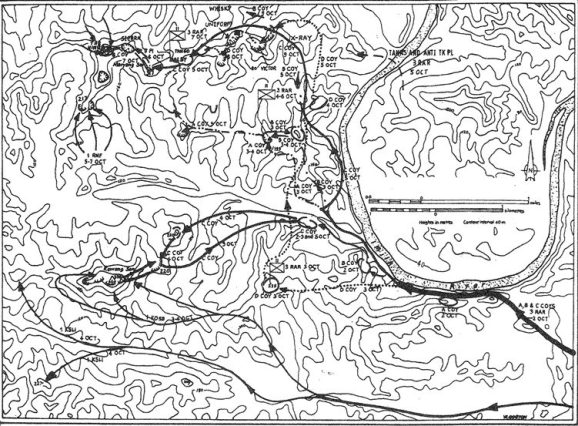
Map B. The battle of Maryang San, 3-7 October 1951. From O'Neill's official History of Korean war.
My job was to ensure that maps of the area and what was known of the enemy were distributed down to platoon commanders. I think for once one map was suitable and we were not going to operate where four maps joined. I was part of battalion tactical headquarters (Tac HQ) to assist the CO and I did this by keeping his map up to date, speaking to the company commanders on the radio when the CO wasn't available, conveying his orders and keeping the Adjutant (Captain Bill Keys) at battalion headquarters up to date with the operations as they progressed.
2 October
The Plan
Final orders were issued on 2 October. The CO decided to make his major effort with three companies along the more prominent ridge line running east from Hill 317. B Company followed by D Company with C Company in reserve with A Company attacking along the ridge line running south-east, down the enemy on that axis and to confuse him as to our main thrust.(7) All, approach moves would be at night to achieve surprise. The final movement to the assembly area on 2 October in single file and at 50 yard intervals was completely successful and the battalion, including Tac HQ, was concentrated by last light to the east of Hill 238 ready for Phase 1 next day. C Company and the Mortar Platoon were heavily shelled and mortared during the afternoon. The Chinese must have taken this movement as patrolling for they did nothing to investigate what was going on.
3 October
The Execution
B Company lead by Lieutenant Jim Hughe's Platoon moved off at 0300 hours on 3 October to cover the 3000 metres to Hill 199. They traveled in darkness over heavily timbered and broken ground and arrived at the kidney shaped feature to the east of Hill 199. At 0500 hours the divisional artillery and mortars engaged known enemy artillery and mortar positions. A heavy mist from the Imjin River was a two edged weapon (good for security-bad for navigating) but the company assaulted and captured Hill 199 by about 1015 hours suffering 3 WIA but killing 5 enemy wounding many and taking one POW. The company then handed over Hill 199 to A Company and withdrew back to the kidney feature and dug in under enemy shell and mortar fire.
After much difficulty three tanks of the 8th Hussars joined A Company on Hill 199 and with a section of MMGs began firing in support of the KOSBs attack.
The tanks and MMGs kept up their fire all day despite retaliatory artillery and mortar fire but the Chinese were too strong and the attack on Hill 355 was called off with-out the summit being reached.
The attack was renewed the next morning but this time with further help from 3RAR. That night the Brigade Commander, Brigadier Taylor, had asked Lieutenant Colonel Hassett to capture the two 220metre features to the north; east of Hill 335 from where the Chinese were shooting up the KOSBs. C Company, the battalion reserve, under Major Jack Gerke was given this task and set off at 0500 hours on 4 October.
4 October
7 Platoon (Lieutenant Maurie Pears) led the advance across the valley and emerged out of the mist just 30 metres below the first enemy position. The Australians had surprised the enemy and began their assault at 0900 hours. After hand-to-hand fighting and being fired upon from the second 220 feature the position was quickly captured. The momentum of the assault carried the company onto the second objective, a well-fortified position, and this was captured by 1100 hours with the enemy fleeing down the rear slopes of Hill 355. Pte J Burnett, a bren gunner, was to be awarded a DCM for his bravery in this attack. With the bagpipes of the KOSBs in their ears C Company pushed on and with artillery and MMG support gained the summit of Little Gibraltar at about 1400 hours and the brigade's first objective was ours. C Company then handed Hill 355 over to the KOSBs and withdrew to consolidate on the two 220 features to be prepared for any enemy counterattacks that night. The next morning C Company returned to the area of Hill238. Arther Stanley CSM C Company said later greatcredit for the success of the operation must go to Major Gerke:(8)
Tac HQ 3RAR with OC Mor PI (Captain Rene Lemercier), OC MMG PI (Captain Reg Saunders the only aboriginal to be commissioned in the Australian Army), and the Assault Pioneer Platoon (Lieutenant 'Jock' McCormick) as well as A and B companies regrouped around Hill 199 during the afternoon of 4 October and D Company to a position 700 metres to the north-east of Hill 199 ready for the main attack next morning.
The divisional artillery, supplemented by two batteries of 8 inch howitzers and three batteries of 155mm guns, pounded the enemy positions during the night. Air strikes continued the next day.
5 October
Early the next morning Tac HQ moved 1000metres north of Hill 199 to observe the movement of the companies during the attack and C Company moved to a reserve position north-east of Hill 199. B Company moved off at 0445 hours and travelled about 2000 metres north in the dark over very rough terrain with a heavy mist enveloping their every step. D Company followed 30 minutes later and when both companies reached the next ridge line code named XRAY with D Company to the east of B Company they turned west and proceeded to the first objective VICTOR. These two companies were protected on their right flank by Captain Arther Rofe's Anti-tank Platoon ( in an infantry platoon role) and a troop of tanks which had crossed from the east bank of the Imjin River about an hour before first light.
The enemy must have been alerted by the noise of these tanks and those with A Company for when B Company veered too far to the north they were engaged by the enemy on WHISKEY but this feature was quickly captured. D Company navigating correctly moved up the steep slope on the left of B Company and although still in the thick mist were engaged by the enemy on VICTOR.
The mist suddenly lifted about 1030 hours with D Company half way up the slope and dangerously exposed to an enemy hastily reorganizing for an attack from an unexpected direction and Major Basil Hardiman had no option but to order D Company to attack. B Company was too far north to participate in the attack but was able to give D Company fire support as they advanced up the ridge line
Hardiman and Lieutenant Geoff Leary (10 Platoon Commander) were wounded and without hesitation Lieutenant Jim Young took over the company. By 1140 hours D Company was in control of the first knoll code named VICTOR but had suffered seven wounded in the process.
The enemy withdrew up the ridge line Sergeants Bill Rawlinson and Vince Brown took over Young's and Leary's platoons respectively while casualties were carried back by the prisoners escorted by the walking wounded.
In the fog of war Young didn't know exactly where they were so he was instructed to display a air-marker panel (as suggested by the CO's signaller) and their correct position was determined. The CO then asked Young whether he could go on to attack UNIFORM and Young replied "give me twenty minutes of heavy supporting fire and I'l have it".(9)
Whilst B and D Companies were advancing along the western ridge line A Company, with a troop of tanks, advanced west from Hill 199 and kept the enemy's attention from the main assault by D and B Companies. A Company had advanced along the north-west spur leading to Hill 317 with infantry. They proceeded along the valley with tanks and infantry and with successive platoon attacks the company reached a point 600metres from the summit by mid-afternoon. Each platoon was led by very experienced leaders who were present during the battle of Kapyong. They were Lieutenant 'Freddie Gardiner (1 PI), and Sergeants George Harris (2) and Jim Eveleigh (3). Their advance had confused the enemy as to the direction of our main attack and been slowed by strong Chinese resistance and continuous artillery and mortar fire. A Company suffered twenty casualties, twenty of the enemy were killed and two captured on this day.
Meanwhile the CO directed artillery, MMG, tank and mortar bombardment of D Company's next objectives for an attack to start at 1400hours. Lieutenant Algie Clark's 11 Platoon captured UNIFORM the first knoll of the remaining three still occupied by the enemy. 12 Platoon under Sergeant Howlinson lead the assault onto the second knoll and when the last knoll had been captured by 11 Platoon at about 1600 hours an enemy company had been completely decimated with sixty eight killed and thirty captured since the first attack by D Company that morning. The company was down to fifty men after suffering three killed and fourteen wounded.
It had been obvious to the CO early in the afternoon that D Company would not be strong enough to go to the summit and after a discussion with Captain 'Wings' Nicholls he decided that B Company had had enough too so this left C Company. Major Gerke had been located with Tac HQ all day so that he could be kept in the picture and be ready at short notice for his next task. His company was to position itself on the reverse slope behind D Company ready to pass through that company and take Hill 317 when UNIFORM had been secured.
Realising that speed was essential Gerke raced his company through D Company and before the Chinese realised what was happening BALDY had been cleared by 8 Platoon (Lieutenant Russ McWilliams) and Hill 317, now unoccupied, the enemy being driven off by the shelling, captured by 7 Platoon (Pears) about 1700 hours capturing ten prisoners. Tanks, artillery, mortars, MMGs and D Company provided the necessary fire support and discouraged any movement from the north. C Company had done it again and it is no wonder that Jack Gerke was later awarded the DSO.
The Chinese began to bombard C Company and caused quite a more casualties during their difficult reorganisation on the hill. The CO was very concerned for the security of C Company and in anticipation of an enemy counter-attack that night sent a platoon (No2 under Sergeant George Harris) from A Company, the Assault Pioneer Platoon and a section of MMGs (Sergeant Jack Morrison) to Maryang San to support C Company. A Company less 2 Platoon withdrew to the vicinity of Hill 199 and became the battalion reserve.
Further to the west the Fusiliers had encountered strong resistance and although they had a toe-hold on Hill 217 the Chinese had repulsed them. At least they had drawn some enemy attention away from 3RAR's operations but had suffered heavy casualties during the day. During the night the CO and Gerke decided that C Company should probe towards SIERRA the next morning to give depth and more security to Hill 317.
6 October
At 0700hours an under-strength 8 Platoon under Lieutenant Arthur Pembroke advanced under the cover of mist, completely surprised the enemy and captured SIERRA a very heavily wooded knoll about 400 metres to the west of Hill 317. The Chinese reacted vigorously with a number of counter attacks and continuous artillery and mortar bombardment throughout the day but Pembroke's platoon held firm and SIERRA remained in C Company's hands.
The Fusiliers attacked again that morning but were repulsed a second time by the Chinese defending Hill 217. Brigadier Taylor then reasoned that the only way to capture Hill 217 was from Hill 317 via THE HINGE. He asked lieutenant Colonel Hassett to capture THE HINGE. Lieutenant Colonel Hassett agreed to do the job next morning.
B Company was given this task and late that afternoon moved up to Hill 317 and joined 8 Platoon on SIERRA. The CO had put A Company on twenty minutes notice to move in case the Chinese counter-attacked that afternoon but later when the situation became quieter that company was stood down and returned to Hill 199.
7 October
B Company's attack was timed for 0800 hours so at first light the CO moved Tac HQ up to Hill 317 to observe and command the whole operation. This day was to be remembered forever by those who experienced it. B Company attacked with 4 (Hughes) and 6 (Lieutenant Brian Falvey) Platoons forward with supporting artillery, mortar, tank and MMG fire. When the assaulting troops reached the objective the Chinese appeared from concealed positions behind them and attacked company headquarters and 5 Platoon (Sergeant John Parry). A fierce fire fight ensued and after suffering a number of casualties and inflicting many more on the enemy B Company gained control of THE HINGE at about 0920 hours. The enemy reacted immediately by subjecting the defenders all along the ridge from Hill 317 to THE HINGE to intense and accurate artillery and mortar fire. This continued all day long and inflicted many casualties. The CO was an inspiration to all that day as he showed great courage, visited 8 Platoon, directed supporting fire and ensured that casualties were looked after and re-supply was carried out. Its a miracle that anyone survived the Chinese bombardment that day.
The members of Tac HQ (CO, BC and IO with signallers and Mortar Platoon Commander) were located on the western side of the peak of Hill 317 using slit trenches dug by the Chinese.
Luckily for us most of the Chinese artillery shells passed over the top of the hill but not so lucky for the Korean porters bringing, supplies up the hill. The CO could see down the ridge line to B Company and directed supporting fire accurately.
I operated the CO's radio to receive sit-reps, from B company in particular, and pass these reports on to the Adjutant in BHQ now located with A Company on Rill 199. Radio communications between BHQ and the forward companies was very difficult because of the high terrain in between their locations and the constant disruption to the telephone line by enemy fire.
The enemy was expected to counter-attack in battalion strength that night so McWilliam's 8 Platoon was sent forward to reinforce B Company on THE HINGE and the Anti-tank and Assault Pioneer Platoons brought up to strengthen C Company on Hill 317 and SIERRA.
The battalion supply line was now stretched to the limit and although the company seconds-in-command had Korean porters under their control it was an extremely difficult job to resupply their company with ammunition, rations and sometimes packs as well as evacuate the wounded and escort prisoners to the rear.
I remember well that it was on the 7 October that the battalion made its first request for a helicopter evacuation of a badly wounded soldier and it took a great deal of persuasion to get it. The re-supply echelons, stretcher bearers and linesmen worked with particular dedication that day under frequent artillery fire and without their support the companies would not have been able to achieve as much as they did.
Lieutenant Colonel Hassett was considering what to do if the Chinese attacked Hill 317 and recalled later we were now in a critical situation. We had been moving and fighting, almost without cessation, for six days. We had lost over a hundred men and looked like losing a lot more. Platoons were now 15 to 20 strong, too low for orthodox tactical use. It was not just the casualties. Most were physically exhausted.
The battalion was just about spent. A counter-attack by A Company, which itself was not in top shape, would be about our last major effort.(10) Consequently at 1435 hours A Company was put on 15 minutes to move but as the situation seemed to ease later in the day A Company was stood down as they had been the day before. Their presence in the area of Hill 199 gave some security to the company porter re-supply trains that trudged up the slopes to the Hill 317 area and provided depth to the defence.
Tac HQ returned to BHQ co-located with A Company on Hill 199 at last light. An ominous silence prevailed over the battlefield from 1930 hours until 2000 hours when the silence was broken with a most intense and concentrated thirty minute bombardment of B and C Company positions prior to the expected battalion attack.
There were three battalion sized counter-attacks against B Company that night and each were repulsed with heavy casualties suffered by the Chinese. The attacks ceased at 0500 hours the next morning with 120 enemy counted KIA. The Australians ceased firing to allow the Chinese to evacuate their wounded. B Company had used four 'first lines' of ammunition during the night but this was only possible by the courageous efforts of the Assault Pioneer Platoon in carrying this ammunition forward in the dark and under fire.
D Company was still occupying features UNIFORM and BALDY to the east of Hill 317 to give further security from the north and north-east. The company second-in-command Captain 'Paddy' Moloney had taken over from Young on 7 October but he too was to be wounded and Young once again assumed command.
During the night the CO told the Brigade Commander 'that we had taken heavy casualties-about 120 including those wounded and still fighting-which meant that about 1 in 3 at the sharp end had been hit and that the Battalion was exhausted after six days of moving, digging and fighting. The Battalion was, in truth, out on its feet'.(II) Consequently B Company was relieved by A Company of the KOSBs on the morning of 8 October and moved to feature VICTOR to the east of Hill 317. (See KOSB article Duty First Dec. 92. Ed). C Company left one platoon with the Assault Pioneer Platoon on Hill 317 and moved to Hill 199 for a well-earned break.(12) A Company then moved to X-RAY whilst Tac HQ and the Mortar Platoon consolidated on Hill 199 with C Company. The Fusiliers were able to occupy Hill 217 because the Chinese had abandoned the feature when they had realised the position was now untenable.
9 October
Early in the morning B Company KOSBs relieved the Antitank, Assault Pioneer and C Company platoons on Hill 317 and SIERRA which meant that the KOSBs had now replaced 3RAR on those objectives.(12) 3RAR was now located to the east of Hill 317 protecting the right flank of the brigade to the north and east to the Imjin River. The enemy although beaten was still active and engaged 3RAR ositions with SP and artillery fire without inflicting any more casualties. The Jamestown Line was now occupied by the Commonwealth Division and Operation Commando completed. The battalion was to remain in the area east of Hill 317 for the next few weeks to consolidate their defences. Just after the comedian Danny Kaye had visited 3RAR on 4 November the Chinese launched an offensive and re-captured THE HINGE and Hill 317 much to the disappointment of all members of 3RAR.
The battalion was finally withdrawn to the Widgeon crossing area (from where they commenced Operation Commando) towards the end of November. A full circle had been completed but with astonishing achievements in the process.
The official history records that The Australian Battalion had destroyed at least two Chinese battalions during the five-day battle. The Australians had counted 283 enemy killed and had taken 50 prisoners. Several hundred more would have been killed or wounded. 3RAR lost twenty killed and eighty-nine wounded including fifteen who remained on duty.(13) Lieutenant Colonel Hassett was awarded an immediate DSO whilst another was awarded to Major Gerke. After leading his company in such an exemplary manner for the first five days of the operation Major Jack Gerke was wounded on 7 October but refused to be evacuated until the next day when Captain Lee Greville, his second-in-command, took over the company.
I have not mentioned the achievements of the Mortar, MMG, and Signals Platoons, stretcher-bearers and administrative echelons but they played their part as equally and effectively as everyone else in the battalion. Lieutenant Jimmy Stewart and Captain Arther Dodderal the seconds-in-command of the Signal Platoon and B Company respectively were both awarded the MC for their courage and leadership under fire. The Kiwi gunners of 16NZ Fd Regt who fired about 50,000 rounds in supporting 3RAR, and the troopers of the 8th Kings Royal Irish Hussars gave magnificent support so much so that the alliance between the 8th Hussars and 3RAR was cemented during Operation Commando. Operation Commando was a classic example of a conventional division in the attack which had not been seen by Australians since the 9th Australian Division's participation in the battle of EI A1amein in October 1942. The part played by 3RAR is especially worthy of detailed study because all the principles of the attack were graphically illustrated time and time again. 3RAR had recently seen many original veterans replaced mostly with fresh but inexperienced reinforcements. They were to 'prove as good' as any that had preceded them and the fact that a further thirty-six members were decorated for their leadership and bravery during the six days of the battle of Maryang San is testament enough.
That they had to suffer the impact of the heaviest concentration of enemy artillery, mortar and rocket fire of the Korean war is further testament to the ability of the Australian soldier to overcome extreme adversity.
Notes:
1. United Service, Vol 46, No 3, Jan 93, Page 33.
2. O'Neill R. Australia in the Korean War, Vol 11, Page 184.
3. ibid, and Headquarter Training Command's The Battle Maryang San Page 6 give different views on where the enemy battalions were.
4. 3RARWD 27 September 1951.
5. United Service, Vol 46, No 3, Jan 93. Page 33.
6. O'Neill R. Australia in the Korean War, Vol 11, Page 184.
7. United Service, Vol 46, No 3, J~ 93, Page 33.
8. ibid page 35.
9. O'Neill R. Australia in the Korean War, Vol 11 , Page 191.
10. HQ Training Command, The Battle of Maryang San, 1991. Page 88.
11. United Service, Vol 46, No 3, Jan 93, Page 43.
12. 3RARWD, 8 and 9 October 1951.
13. O'Neill R. Australia in the Korean War, Vol 11 , Page 199.
Bibliography
* 3RAR War Diary, September and October 1951 less the annex which described the battle of Maryang San from 28 October.
* O'Neill R. Australia in the Korean War 1950-53, Volume II; Combat Operations, AWM and AGP~ 1985.
* Headquarters Training Command, The Battle of Maryang San, 3RAR Korea 2-8October 1951 . Edited by Lieutenant Colonel R Breen.
* USI of NSW, United Service, Volume 46,Number 3,January 1993.
Kirkland F. and Pears M., Korea Remembered Project, 7 January 1997 Chapters 7,8, and 10.
Appointments Operation Commando
Korea 1951
CO Lt Col F.G. Hassett
2ic Maj J. Carey
Adjt Capt AW. Keys
AlAdjt Lt I.RW. Brumfield *
10 Lt F.P. Scott
Sp Coy
OC Maj A. F. P. Lukyn
Mor Pl Capt R.J. P. J. Lemercier
Sig Pl Capt C. Smeal
2ic Lt J. D. Stewart
Pnr Pl Lt J. McCormack
Atk Pl Capt A.W. Rofe
MMG Capt R.W. Saunders
HQ Coy
OC Capt ‘Bing’ Crosby
QM Capt R. Wally
RMD Capt R. Barnes
Chap
Chap P. Phillips
Chap B.W. Brooker
A Coy
OC Capt J. J. Shelton
2ic Capt A.V. Preece
1Pl Lt R. Gardner*
2Pl Sgt G. Harris*
3Pl Lt M. Moore
B Coy
OC Capt H. W. Nicolls
2ic Capt A.S.R. Doddrell*
4Pl Lt J.C. Hughes
5Pl Sgt J.E. Parry
6Pl Lt B.J. Falvey
C Coy
OC Maj J. Gerke*
2ic Capt L.R. Greville
7Pl Lt M.B. Pears
8Pl Lt R.J. McWilliam*
9Pl Lt A.T. Pembroke
D Coy
OC Maj J. Hardiman
2ic Capt J.C.F. Moloney
10Pl Lt G.J. Leary
11Pl Lt L.G. Clark
12Pl Lt J.H.A. Young
* - Has been present during the Battle of Kapyong.
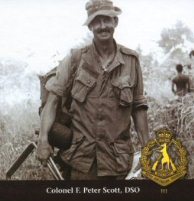
Vietnam 1971
Colonel F.P. ‘Peter’ Scott DSO (RL) was IO 3RAR Maryang San.
Later 1969-71, CO 3 RAR Vietnam.
See: Publications - Command In Vietnam - Reflections of a Commanding Officer
 |
| The 3 RAR Internet site gratefully acknowledges the assistance of 101 design of Wollongong. www.101design.com.au |